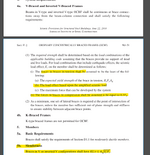RWW0002
Structural
- Jun 10, 2011
- 372
Forgive me in advance if there is an existing thread that discusses this topic. My search prowess seems a bit lackluster with the website overhaul.
I am looking at an Ordinary Concentrically Braced Frame (OCBF) per AISC 341-10.
Inverted V-Type chevron brace.
Relevant code sections include 341-10 F1.4a and F1.5b

It appears that for V and inverted V braces in OCBF brace slenderness is limited to 4/sqrt(E/Fy). This results in some fairly stocky braces. I have no problem with this and understand the rationale.
However, these stocky braces sometimes leads to some odd conditions when it comes to investigating unbalanced forces on the brace beam. In my current case the post-buckling compressive strength of the brace (0.3Pn for OCBF) exceeds the required tension brace force (limited by load effect based on amplified seismic load). By the letter of the code, it appears that one would have to check unbalanced forces in the brace beam with the compression force exceeding the tension force. This does not seem consistent with my understanding of the code intent. If 0.3Pn>ΩoE or the max force that can be delivered, it seems to me that no further investigation into unbalanced forces is required. This may be exactly the intent of the code and one of the reasons for the low slenderness limit for OCBF (that is not present for SCBF), but I wanted to get other's opinion.
Thanks.
I am looking at an Ordinary Concentrically Braced Frame (OCBF) per AISC 341-10.
Inverted V-Type chevron brace.
Relevant code sections include 341-10 F1.4a and F1.5b

It appears that for V and inverted V braces in OCBF brace slenderness is limited to 4/sqrt(E/Fy). This results in some fairly stocky braces. I have no problem with this and understand the rationale.
However, these stocky braces sometimes leads to some odd conditions when it comes to investigating unbalanced forces on the brace beam. In my current case the post-buckling compressive strength of the brace (0.3Pn for OCBF) exceeds the required tension brace force (limited by load effect based on amplified seismic load). By the letter of the code, it appears that one would have to check unbalanced forces in the brace beam with the compression force exceeding the tension force. This does not seem consistent with my understanding of the code intent. If 0.3Pn>ΩoE or the max force that can be delivered, it seems to me that no further investigation into unbalanced forces is required. This may be exactly the intent of the code and one of the reasons for the low slenderness limit for OCBF (that is not present for SCBF), but I wanted to get other's opinion.
Thanks.
